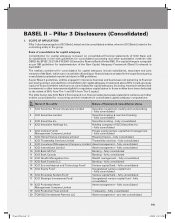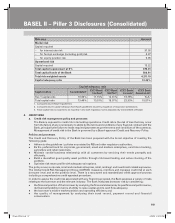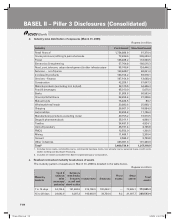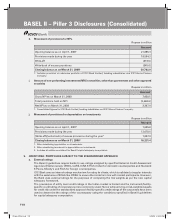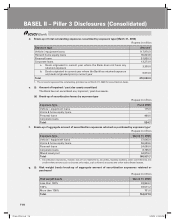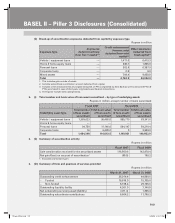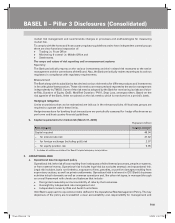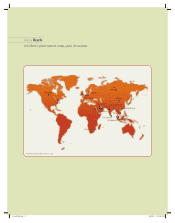ICICI Bank 2008 Annual Report Download - page 177
Download and view the complete annual report
Please find page 177 of the 2008 ICICI Bank annual report below. You can navigate through the pages in the report by either clicking on the pages listed below, or by using the keyword search tool below to find specific information within the annual report.
F103
As per Basel II guidelines the external rating of the facilities of the counterparty is contingent upon the
ratings of any instrument currently rated by the credit rating agency for the counterparty. The lower
rating, where there are two ratings and the second-lowest rating where there are three or more ratings
are used in cases where multiple ratings for a given facility were available. The mapping of external
ratings to Bank’s facility has been undertaken on a case by case basis, using Bank’s exposure as at
March 31, 2008 and checking for pari passu and maturity conditions associated with the tenure of the
facility. The list of approved agencies as per Basel II guidelines for non-resident corporates includes
Standard & Poors, Moody’s and Fitch. Further, ratings for mutual fund schemes have also been obtained
from the ratings mapping provided by the individual ratings agencies.
b. Credit exposures by risk weights
The table below discloses the amount of the Bank’s outstanding for credit exposures in three major risk
buckets
Rupees in million
Exposure Category Amount outstanding1
Less than 100% risk weight 1,373,923.0
100% risk weight 2,375,657.9
More than 100% risk weight 948,472.0
Total24,698,052.9
1. Includes credit exposures and excludes investment & derivative exposures covered in market risk.
2. Includes all entities considered for Basel II capital adequacy computation.
6. CREDIT RISK MITIGATION
a. Credit risk mitigation policy
The Bank defines collateral as the assets or rights provided to the Bank by the borrower or a third party
in order to secure a credit facility. The Bank would have the rights of secured creditor in respect of the
assets/ contracts offered as security for the obligations of the borrower/ obligor.
Collateral valuation and management
As stipulated by the RBI guidelines, the Bank uses the comprehensive approach for collateral valuation.
Under this approach, the Bank reduces its credit exposure to a counterparty when calculating its capital
requirements to the extent of risk mitigation provided by the eligible financial collateral as specified in
the Basel II guidelines.
In line with Basel II guidelines, the Bank adjusts the value of any collateral received to adjust for possible
future fluctuations in the value of the collateral in line with the requirements specified by RBI guidelines.
These adjustments, also referred to as ‘haircuts’, to produce volatility-adjusted amounts for collateral,
are reduced from the exposure to compute the capital charge based on the applicable risk weights.
Types of collateral taken by the Bank
ICICI Bank determines the appropriate collateral for each facility based on the type of product and
counterparty. In case of corporate and small and medium enterprises financing, fixed assets are generally
taken as security for long tenor loans and current assets for working capital finance. For project finance,
security of the assets of the borrower and assignment of the underlying project contracts is generally
taken. In addition, in some cases, additional security such as pledge of shares, cash collateral, charge
on receivables with an escrow arrangement is also taken.
For retail products, the security to be taken is defined in the product policy for the respective products.
Housing loans and automobile loans are secured by the security of the property/ automobile being
financed. The valuation of the properties is carried out by an approved valuation agency.
The Bank also offers products which are primarily based on collateral such as shares, specified securities,
warehoused commodities and gold jewellery. These products are offered in line with the approved
product notes which also deal with types of collateral, valuation and margining.
BASEL II – Pillar 3 Disclosures (Consolidated)
1P-less_(Pillar).indd 1031P-less_(Pillar).indd 103 6/20/08 4:52:56 PM6/20/08 4:52:56 PM


